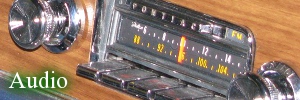















Pentagon Grand Challenge: $1 Million to Builder of Robotic Vehicle |
|---|

 Topics: DARPA Challenge
Topics: DARPA Challenge
|
Mike O'Sullivan
February 27, 2003
Los Angeles, California
Audio Version 623KB RealPlayer
U.S. defense officials have issued a challenge to inventors, off-road racers and robot enthusiasts: build a robotic vehicle that can travel almost 500 kilometers over rugged terrain, for a prize of $1 million.
The ground rules are simple: build a mobile robot that can travel on its own over roads and deserts, through gullies and waterways. The precise course between Los Angeles and Las Vegas will only be revealed hours before the race, on March 13, 2004.
The winner, if there is one, will receive $1 million, courtesy of the Defense Advanced Research Projects Agency, or DARPA. The research and development branch of the U.S. Department of Defense, DARPA helped develop the internet, smart bombs and stealth aircraft.
Defense officials say they are reaching out to people who work in their garages and basements, where innovation often takes place.
Air Force Colonel Jose Negron says the officials know that good ideas are not restricted to big defense contractors. "We're trying to attract the enthusiast, the amateur, with a passion for the idea that he's pushing," he explained.
Organizers recently outlined the ground rules to some 350 enthusiasts. The unmanned vehicles can get no human help. They must be self-propelled and self-navigating, but their weight and size are not restricted.
A confident Matthew Blake of Scarab Robotics says his small firm has a chance of winning. "We're planning on fielding an autonomous robot to get from Los Angeles to Las Vegas and win the million dollar bounty," he said.
Mr. Blake's company designs software for robots, and now has a machine that will travel 16 kilometers per hour. It will need to go three times that fast to cover the rugged course within the 10-hour limit.
The defense agency enlisted help from an organization called SCORE, which usually conducts desert races with off-road vehicles guided by human drivers. SCORE president Sal Fish is helping select the route, and says the terrain will be difficult, but not impassable. He has driven over three proposed routes in a pickup truck.
"We have [everything] from graded power line type roads, hard surface streets, which would be asphalt or pavement, volcanic rock, inclines, silt beds, dry lake beds, such as Bonneville Salt Flats, washes, water crossings," Sal Fish pointed out.
He says there is every possible type of terrain that a robotic vehicle would encounter in combat.
And that is important, says DARPA director Tony Tether, since the challenge is intended to develop new combat devices. Congress has told the U.S. military that in the future, one-third of its battle systems must be unmanned. DARPA officials say robotic vehicles can be used for reconnaissance, and with human guidance, for fighting. Mr. Tether says a long range robotic vehicle has not yet been developed.
"This is not something that we know how to do today," he said. "On the other hand, it's something that all of our military forces are projecting in the future that they will need in order to reduce the number of people that they need to take with them to a battle zone. So I'm hoping that we will have people work on a problem which is really at the heart of our future military doctrine that ordinarily would not work on that problem."
The goal for competitors is to build an effective team, says Greg Horton, one of the entrepreneurs and enthusiasts to respond to the DARPA challenge. Mr. Horton's company, DMG Marketing, develops and promotes the ideas of inventors. It is now marketing a racing vehicle.
"There's a vehicle that we have that's an indoor racing vehicle. We want to see if we can modify that to participate in this challenge," Mr. Horton said.
For Dave Buckley of Scarab Robotics, there are two problems to be dealt with; first, the question of how to get a vehicle from point A to point B without human help.
"You also have the tactical navigation problem of dealing with the rock that's right in front of you, or the ditch or river," he said. "And so what we're looking for here is to play up our strengths. Our strengths are basically in the software end of things, and we're looking for people who have experience with platforms, mechanical platforms, that will get us across the desert."
And a critical part of any team is the financier or sponsoring corporation, which may spend far more than $1 million to develop a winning entry.
For the Defense Department, the total project cost will be $2.5 million. DARPA director Tony Tether says that's a bargain to secure cutting-edge technology.
"I believe that somewhere out there, there are some kids and people, maybe even in defense companies, that have an idea how to do this, that just have not had the opportunity because they didn't hear about it, because there wasn't any excitement there," Tony Tether said. "We're really trying to tap into very high-IQ people and kind of get 10 minutes of their time. And if we can do that, there's somebody there with an answer."
DARPA officials say that if no one wins this challenge, they will hold another race 12 to 18 months after the first one. The project is open only to U.S. companies or U.S.-based groups, but international competitors can be part of a team. The challenge has been funded through 2007, and congressional funding could be extended beyond that.
